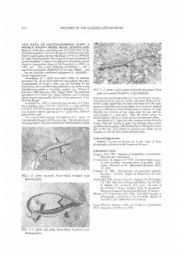
New data on Cryptoblepharus fuhni, a poorly known skink from Queensland PDF
Preview New data on Cryptoblepharus fuhni, a poorly known skink from Queensland
2M MEMOIRS OFTHEQUEENSLANDMUSEUM NEW DATA ON CRYPTOBLEPHARVS FVHNI, A POORLY KNOWN SKINK FROM QUEENSLAND. MemoirsoftheQueenslandMuseum35(I)2.14.1994:- Cryp- toblepharusfuhniCovacevich&Ingram, 1978isknownonly fromitstypelocality,theMelvilleRange(14°16'S,144°30'E) onCape YorkPeninsula. Thisrangeiscomposedentirelyof graniteboulders.C.fuhniisrecognisedaswarrantingspecial £?®g status in managementplans by McDonald et al. (1991), as '2RC i.e.* ...with a very restricted distnhution — with a „ maximumgeographicdistributionoflessthan 100km...rare .., but notcurrently considered endangered orvulnerable ... withinanationalpark.,,'. Description of C. fuhni was based solely on museum specimens (8),all ofwhich hadbeendamaged bydustshot. A photograph of living C. fuhni was not available for the description,andnonehasbeenpublishedinanyofthemajor identification guides to Australia reptiles, (e.g. Wilson & FIG. 3. C.fuhnitypical pale-coloured specimen, from Knowles. 1988;Ehmann, 1992,Cogger. 1992).Noadditional pale sca-washedboulders. Cape Melville. specimens of C\fuhni have been collected, and it remains poorlyknown,presumablybecause ofihe remotenessof(he fromthesea,nearBathurstBay(J.Covacevich,pcrs.comm). MelvilleRange. Juveniles from this area are similar, but moredistinctly pat- InSeptember, 1992, 1 visitedthetypelocality ofC.fuhni terned. Large,apparently oldadultspecimenshavethesame from Bathurst Bay (14°I.VS, 144°2*2'E) to Cane Melville patternasjuvenilesandyoungadults,butitispoorlydefined (14°WS, 144°30*E)and wasabletophotograph(Figs 1-3), and on a dull brown-black background (vs black). At Cape and examine closely specimens of C. fuhni from different Melville the boulders of the range enter the sea, and are partsoftherange. wave-washed to a pale grey. Here the skinks retain the The colour and pattern description of C. fuhni of distinct pattern,buthaveapalegreyishbackgroundcolour. Covacevich&Ingram(1978)isaccurate.Thetypespecimens IndividualsofC.fuhniareverycommonon the Melville areyoungadults.Allwerecollectedonblackbouldersremote Range. They areextremely agile, fast-moving skinks which spendthedayforagingontheboulderfaces.Duringthehottest pan of the day. they retreat to crevices and cracks in the bouldersorintothedeepshadebetweenthem. Acknowledgements Jeanettc Covacevich alerted me to the value of these photographsandassistedmctopresentthisnote. ^:-^Sk^ LiteratureCited Cogger. H.G. 1992. Reptiles & amphibians of Australia' (ReedBooks ChaLswood). Covacevich,J.& Ingram,G.J. 1978. Anundescribedspecies ofrock dwelling Cryptobtepharus (Lacertilia: Scin cidae) Memoirs of the Queensland Museum 18(2): 151)54. Ehmann, H. 1992. 'Encyclopedia of Australian animals. Reptiles'. (Collins Angus & Robertson f'tv Ltd; FIG.J. C. fuhni juvenile, from black boulders near Pymble). Bathurst Bay. McDonald, K,R., Covacevich,J.A., Incram. GJ. &Couperv P.J. 1991 ThestatusoffrogsandVcptilcs. Pp.338-345. QInueIenngsrlaamn,d'Gs.JfroStg.s,Rarveepnt,ileRs,Jbitreddss),&'Amnamamtalalss'p.i (BoardofTrustees,QueenslandMuseum:Brisbane) Wilson.S.K.& Knowles, D.G. 1988. 'Australia'sreptiles.A photographic reference to the terrestrial reptiles of Australia' (W. CollinsPlyLtd:Sydney*. . Ltwis Roberts, Shipson's fiat, via Cookwwn, Queensland 4072, Australia; 26February 1994. FIG. 2. C.fuhni old adult, from black boulders near Bathurst Bay.
